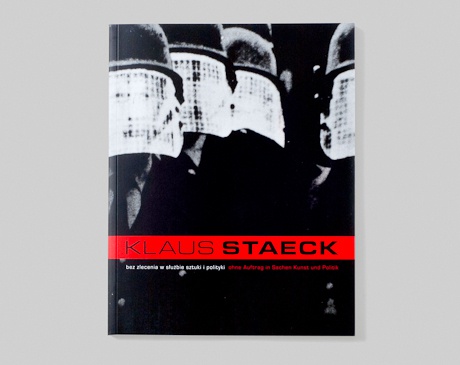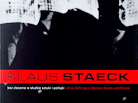book ‘Klaus Staeck — serving art and politics without order’

year of publication: 2008
size: 24 × 29 cm
volume: 112 pages
edition: 500 pieces
binding: softcover
reproductions in colour
languages: Polish/German
graphic design and typesetting: Katarzyna Goczoł, Bartosz Skwarek
publisher: BWA Contemporary Art Gallery in Katowice
ISBN 978-83-88254-47-5
Contents:
Stanisław Ruksza “Klaus Staeck. To Be Applied in the Polish Art”
Klaus Staeck
Biography
Pornografie
Posters
Photography
Objects
Price: 10 zł (about 2,5 euro)
Visit our bookshop or order by e-mail:
ksiegarnia@bwa.katowice.pl

Klaus Staeck — Serving art and politics without order Art versus politics is a theme that had been continuously present in art history of the twentieth century. It often happens that art serves political...

It is the first publication in Poland which is meant to be an exhaustive monograph of this artist. The book contains a comprehensive presentation of the artist's works, as well as texts which expound their genesis and context.
“Staeck's Lesson and the Polish Question
Klaus Staeck […] offers an interesting suggestion both for Polish art, and for politics. He has collaborated closely with Joseph Beuys on many projects, and has participated in numerous editions of Documenta in Kassel. A leftish attitude permeates all his artworks, as he deliberately enters a ground of ideological conflicts.
If we wished to simplify Staeck's work, it could be grouped into the following categories: posters, photographs and objects related to his political activity, a photo book entitled Pornografie and his social-political activism.
Staeck treats photography as a powerful medium. He exploits its tabloid traits, along with its critical potential, and its regular function of recording memories. His photographs investigate the various transformational processes in reunified, constantly changing, Germany. These are the economic, for example, ‘Bitterfeld, September 1991’, and the social, such as ‘Köln, November 1993’, as well as earlier issues such as a prosperous society, and German tourism, for example. ‘Marbella, September 1988’, or the mingling of art and corporate money seen in ‘Berlin, Debis-Haus, 29th January 2000.’
Staeck's photographs certainly constitute an iconic companion to a 'democracy lesson' in post-1990 Germany, yet we have not come across a similar publication in Poland in the period following the year 1989 (1).
His photo book Pornografie from 1971 could be seen in a similar manner. It features everything currently making up the visual iconography of leftish movements, alterglobalism, and most of all, the menace and injustice which they contest. Pornografie is an atlas abounding in images of torture, crime, political abuse, war and globalisation issues. It is a seismographical picture of political 'meat', the collective memory of social revolution, of the terrorism perpetrated by the then budding organizations, such as RAF on the one hand, and the Black September Group on the other. Until now we have not been presented with a real catalogue depicting the social and political tensions in Poland, either those from the second half of the 20th century, or the current division between 'Poland A' and 'Poland B' (2).”
Stanisław Ruksza
“Klaus Staeck. To Be Applied in the Polish Art”
fragment of the book
1) It is worth noting that transformation in Poland was 'recorded' in painting only in the late 1990s by Ładnie Group. However, their work has not gained proper appreciation.
2) The need to record Polish reality seemed evident in the exhibition entitled “The New Documentalists”, Centre for Contemporary Art Ujazdowski Castle in Warsaw, 13 June — 30 August 2006, curated by Adam Mazur.
'Archeology of photography' by Jerzy Lewczyński, who has strongly emphasised the subject of memory and recording reality since early 1970s, is also worthy of attention.




